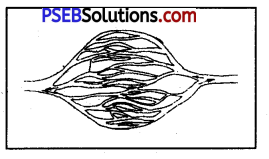Punjab State Board PSEB 10th Class Physical Education Book Solutions Chapter 1 Effects of Exercise on Respiratory System, Blood Circulation, Muscles and Excretion Textbook Exercise Questions and Answers.
PSEB Solutions for Class 10 Physical Education Chapter 1 Effects of Exercise on Respiratory System, Blood Circulation, Muscles and Excretion
Very Short Answer Type Questions
Question 1.
What is pulse rate ?
Answer:
It indicate the rate at which the heart beat. It ranges between 72-80 per minute.
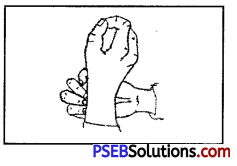
Heart rate is the same as the pulse rate. We can feel the pulse by putting the fingers of one hand on the forearm of the other hand by pressing it.
Question 2.
Write the function of the blood.
Answer:
Blood supplies oxygen to the body and removes waste product through Excretory system from the body.
Question. 3.
What are the uses of nose breathing ?
Answer:
It provides fresh and warm air to the body.
Question 4.
Which gas do we take while breathing ?
Answer:
Oxygen.
Question 5.
What do you mean by Physical Fatigue ?
Answer:
Body becomes lazy and prohibits to do more work. Mental fatigue relates to mind.
![]()
Question 6.
What are the kinds of Fatigue ?
Answer:
It is of two types :
1. Physical
2. Mental.
Question 7.
Name the organs of Blood circulation.
Answer:
- Heart
- Veins
- Arteries.
Question 8.
Which vitamins are soluble in water ?
Answer:
A, B, C vitamins.
Question 9.
Which gas is exhaled during respiration.
Answer:
Carbondioxide.
Question 10.
What is Mental Fatigue ?
Answer:
After doing continuous work body become lazy and prohibits to perform more work. It is called fatigue. When it relates to mind, it is known as mental fatigue.
Question 11.
What are the benefits of Pranayam ?
Answer:
Pranayam improves the health and mind and body become active.
Question 12.
Define Muscles.
Answer:
The skeleton of our body is composed of thousands of fibers. Fibers are attached to one another because of connective tissues. The fibers are as thick as our hair. The muscles contract and cause the movement.
![]()
Question 13.
Name the types of muscles.
Answer:
- Voluntary muscles.
- Involuntary muscles.
- Cardiac muscles.
Question 14.
What is Excretory system ?
Answer:
Excretory system is the one by which harmful and wasteful products are excreted from our body. These wasteful products are urea, carbon dioxide, perspirational water. These products excrete through different organs like lungs, kidney, skin and intestines.
Question 15
Name the organs of Excretory system.
Answer:
Lungs, Kidney, Skin, Intestines.
Question 16.
Give two functions of Muscles.
Answer:
- Our body is in movement because of muscles.
- Muscles act as lever in our body.
Question 17.
What is Voluntary Muscles ?
Answer:
Voluntary Muscles. Voluntary muscles are those muscles which function according to one’s will such as the muscles of legs and arms.
Short Answer Type Questions
Question 1.
What is respiratory system ?
Answer:
By respiration, we mean taking in of air (inhalation) and expelling it out (exhalation). The taking in of air is known as Inspiration and expelling it out is called Expiration. Respiration is very important for human being. Generally, man breathes 20 to 22 times per minute.
![]()
Question 2.
What is Blood?
Answer:
Blood is the red-coloured liquid found in every part of the body. It sends essential elements to the cells and carries waste products from there.
Question 3.
Write down the composition of blood.
Answer:
Blood consists of the following constituents:
- Plasma
- White corpuscles
- Red corpuscles
- Platelets.
Plasma: It is a yellow transparent liquid. It also contains salt. Red and white corpuscles float in the plasma. Red corpuscles are dislike in shape. The span of life of a red blood corpuscles is about 4 months. It is produced in bone marrow and ends in spleen. The chief function of white blood corpuscles is to protect the body against the invading external germs. These cells are colourless and change their shape. They are bigger and smaller in number as compared to red corpuscles. Blood platelets are meant for blood clotting.
Question 4.
What is Blood Pressure ?
Answer:
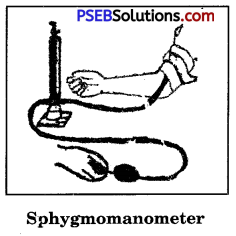
Blood exerts pressure on the walls of those vessels through which it passes. It is called blood pressure. During the period of the contraction of heart, the blood pressure is found to be the lowest in ventricle. During the period of the expansion of heart, Sphygmomanometer the blood pressure is found to be thehighest in big veins. Blood pressure can be measured by shyphogono manameter.
Question 5.
Describe the function of Muscles.
Answer:
Functions of Muscular System:
- Muscles are joined to the bones in the body.
- Muscles act as lever in our body.
- Our body is in movement because of muscles. The various organs of our body function because of muscles.
- Muscles help in the activities of our body such as eating, breathing, talking, etc. No part of our body can function without them.
- Muscles maintain balance among various organs of our body.
- Muscles make use of substances brought by blood in the form of food.
- Like other cells of the body, muscles too, help in excretory process.
Question 6.
Describe the various types of muscles.
Answer:
Types of Muscles
Muscles are of the following three types :
- Voluntary or Striped Muscles.
- Involuntary or Unstriped Muscles.
- Cardiac Muscles.
1. Voluntary or Striped Muscles:
The muscles which work according to one’s will are known as voluntary or striped muscles. These muscles are related to our brain: Among these types of muscles are those of hands, legs, neck, the upper part of the abdomen, etc. With continuous work these muscles are prone to fatigue. These muscles continue to work on the received message, and provide movement to the body, keep the body safe and produce heat in the body.
2. Involuntary or Unstriped Muscles:
Involuntary muscles are those which are not controlled by one’s will or desire. They continue to work unintendedly. Such muscles are found in heart, liver, intestines, etc. They continue to function even when one is asleep. They help in the functioning of blood circulation and digestion. Their chief characteristics are contraction, expansion and flexibility.
3. Cardiac Muscles.
Muscles of heart are a mixture of the first two types of muscles. But they are not under one’s control.
![]()
Question 7.
Write down briefly the structure of skin.
Answer:
Skin has two layers :
(i) The outer layer called Epidermis and (ii) The inner layer called Dermis.
Thousand of cells are formed from the inner layer of epidermis. These cells come to the outer surface and die. Everyday we wipe off lakhs of these cells with clothes or towel. Dermis is made of connective tissues. It has many small and big vessels.
Question 8.
What are the main causes of Mental Fatigue?
Answer:
- Deficiency of nutritional elements in food.
- Soundless sleep.,
- More work load than the capacity of an individual.
- Disease.
- Lack in concentration.
Question 9.
Describe the functions of kidneys.
Answer:
Kidneys. Kidneys are two in number. These are located towards the back side of stomach. They are in shape like that of bean.
Functions of Kidneys
- Urea mixes with blood and enters the kidneys.
- These tubes put out toxic substances like uric acid circulatingin arteries and veins around the nerves.
- Kidneys filter toxic substances like uric acid.
- The waste matter dissolves in water and goes into the big tubes of the tower inside the kidneys.
Tops of the kidney towers have holes. The waste matter and water come in the upper broad portion bymeans of ureter through these holes. From the broad side this urine gets through urethra.
![]()
Question 10.
What is vital capacity of lungs ? Write in brief.
Answer:
Vital Capacity
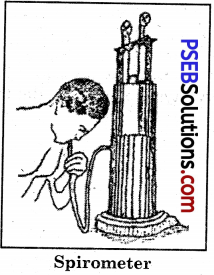
By the vital capacity of lungs we mean that quantity of air which we breathe in of the lungs with the deepest breath. Generally, about 500 cubic cm. air goes into the lungs as we inhale, and about 1800 cubic cm. air comes out of the lungs as we exhale. If we exhale forcefully, another 1500 cubic cm air shall come out but even then about 500 cubic cm. air remains in the lungs. Therefore, we can say that after the deepest inhaling of air, the volumeof air that comes out when air is vigorously exhaled is known as vital capacity of lungs. It is about 4000 cubic cms. The vital capacity of lungs is measured with spirometer.
Question 11.
What is meant by the Composition of Blood ? What are the functions of Blood ? Give its composition.
Answer:
Blood and its composition. Blood is the red coloured liquid found in every part of the body. It sends essential elements to the cells, and carries waste products from there. Composition. If we see a layer of the drop of blood on a glass slide under a microscope we see that there are countless small white coloured particles floating in it. Their colour is slightly yellowish. The collective colour of these countless particles is red. That is why, blood seems to be of red colour.
We can divide blood into the following parts :
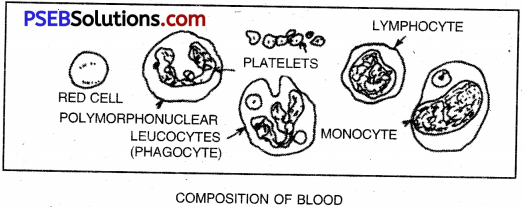
1. Plasma:
It is a yellow transparent liquid in it the Cells of blood continue to float. It contains 90% water and 10% chemical antitoxic substances. This part of blood contains proteins and their amount comes to about 8%. The protein part is called fibrinogen. It also contains salts. It has sodium chloride, magnesium bicarbonate, phosphorus and iron, etc.The remaining part of blood is made of 0.1% fat amino-acid, glucose, uric acid, cretinin, cholesterol, etc.
It provides strength to the tissues. It prepares anti-toxins to kill disease germs. It also performs the function of excreting waste products of the body through excretory system. It has in it nitrogen and urea mixed and it carries it to the kidneys. Kidneys expel it out of the body through urethra.
2. White Corpuscles:
These cells are colourless and change their shape. They are bigger and smaller in number as compared to red corpuscles. For every 500 red corpuscles there is only one white corpuscle. There are 8000 white corpuscles in a cubic millilitre. They are formed in red marrow of the bones.
![]()
Their chief function is to protect the body against the invading external germs. Whenever the disease germs attack our body from the outside, white corpuscles fight and kill them. If the white corpuscles are weak, fhey will themselves be killed, and the body will catch the disease. They repair the torn out tissues of our body. If any part of our body receives an injury, they reach the injured place at once and destroy the germs. They also produce anti-toxins in the body.
3. Red Corpuscles:
If we-examine a drop of blood through the microscope, we find that its colour is white or light yellow. If a group of such cells (one drop of blood) they will look red. It has many small corpuscles which cannot be seen with naked eye. They can be seen only with the help of a microscope. They are disc-like in shape, and are made of small flexible cells.
A cubic millilitre has about 5000,000 red blood corpuscles. They have a compound which is known as Haemoglobin. This compound is made of protein and iron. Ordinarily, 100 gm of blood has 15 gm of haemo¬globin. It has the capacity of absorbing oxygen in it, and forms oxyhaemoglobin. Tissues get oxygen from it.The span of life of a red blood corpuscle is about 4 months. It is produced in bone marrow and ends in spleen. The colour of bile is green because of the dead red blood corpuscles.The main function of these types of corpuscles is to carry oxygen to cells. They also do the work of carrying waste products to vessels by means of blood.
4. Platelets/Thrombocytes:
Blood has some other types of cells which are called platelets or thrombocytes. They are born in sunlight and vitaminised food. They also perform the function of protecting the body against germs of diseases. The body swells up when their number decreases. On being hurt, the whole blood- of the body, because of the presence of these cells, stops flowing and the person is saved.
Functions of Blood. Blood is a vital part of our body. It is impossible for us to live without it. It carries oxygen to various parts of our body, and helps expel waste products produced in the body by excretion.There is a very complex network of blood vessels in our body. After the digestion of food, the digested food mixes from the walls of the intestines with blood of the fine blood vessels.
![]()
The various functions qf blood in our life are as follows:
- It carries oxygen to the various organs of our body. In the presence of haemoglobin, it carries greater amount of oxygen with it.
- It performs the function of expelling carbon dioxide produced in our body because of the process of cellular oxidation
- in the body. It reacts with carbon dioxide and forms sodium bicarbonate. Sodium bicarbonate again undergoes a change
- in the lungs and gets converted to sodium carbonate and carbon dioxide gets expelled. „
- It carries digested food in our body to various parts of our body.
- White corpuscles in the blood protect the body against the invading disease germs.
- Platelets in the blood perform the function of checking the flowof blood in case of injury.
- It keeps our body temperature normal.
- It does the work of carrying such substances as hormones or Anti-toxins to various parts of our body.
- The nitrogenous substances harmful to the body reach the kidney and get converted into urine and expelled out of the body.
- Being liquid, blood produces blood pressure in various parts of the body.
- The Rh factor of blood helps in the sexual selection.
- Blood does the work of carrying injected medicine to the various parts of our body.
Importance of Blood Circulation:
- Blood circulation is vital to our life. Human body dies when the blood stops to circulate.
- It is blood that carries oxygen, digested food and carbon dioxide to various parts of our body.
- It proves to be helpful in excreting the waste products produced in our body.
Long Answer Type Questions
Question 1.
Describe the various organs of Respiratory System. Discuss the effects of exercise on Respiratory System.
Answer:
By respiration, we mean taking in of air (inhalation) and expelling it out (exhalation). The taking in of air is known as Inspiration, and expelling it out is called Expiration.
(a) Inspiration: Diaphragm is like a round dome. When it contracts, it flattens itself in shape, as a result of which the volume of thoracic cavity increases. The air enters from outside rushes in the lungs through respiratory passage.
(b) Expiration: Expiration takes place because of the coming back to the normal position of the chest wall, being flexible and because of the raising up of diaphragm. The pressure on lungs increases, as a result of which air in lungs get expelled.
Importance of Respiratory System
Respiration is an essential activity not only for human being but also for every living creature. A creature can live for some time without water and food but it cannot live ever for a few moments without respiration.
Important Organs taking part in Respiration
The following seven parts are involved in respiratory system:
- Nose
- Pharynx
- Larynx
- Trachea
- Bronchial Tubes
- Lungs
- Diaphragm.
1. Nose.
Nose is the most prominent of all respiratory organs It is a sort of tunnel in the skull. Respiration is possible because of it. The membrane of the nose divides it into two parts. It has three plates of bones in it. .
Functions of Nose.
The functions of nose are as follows :
(i) It warms up the air we inhale. The temperature of the air which we inhale is more than the temperature of the air outside. When air enters the body, it joins the blood vessels and its temperature becomes equal to the internal temperature of the body.
(ii) It purifies the air we inhale. When we inhale, the air from
outside enters our body. This air has numerous dust particles and many other types of bacteria. When this air passes through the nose, the fine hair in the tunnel of the nose separates these unnecessary substances and send pure air into our body. These hair ward off the dust particles and bacteria present in the air at the very outset. These dust particles and diseased germs stick to the soft wall of the nose. This part of the nose has phagocytes which kill the deseased germs and purify the air.
2. Pharynx.
Pharynx is in the shape of a tube made of muscles. It is located in the hinder part of the nose. It is placed below the skull. It has two openings in its hinder part. One of them is called gullet and the other is called glottis for respiration.
3. Larynx.
Larynx is like a box, made of cartilage. This cartilage is made of ligaments joining the muscles. There are membranes on both sides of the larynx, which are called vocal cords. The spacebetween these two membranes is called glottis.
![]()
4. Trachea.
Trachea, a sort of tube, starts from the larynx and in diameter. It is composed of incomplete rings of cartilage. These rings are not joined to the hinder part because the hinder part of the trachea is flat. The rings are 16-20 in number. The inside surface is like the throat. It has small hair to filter the air. This tube at its lower end divides into two parts. One part goes to the right lung and the other part to the left lung. Every part of it is called bronchus.
5. Bronchial Tubes.
The trachea is divided into two parts. These parts are called bronchial tubes. They have cells like those of trachea. These tubes reach the roots of the lungs.
6. Lungs.
Lungs are the most prominent part of the respiratory system. They are situated on both sides of the heart in
the chest. Each lung is covered by a membrane called Pleura. A sticky substance comes out of its middle wall. It saves small bags of lungs (alveoli) from friction of the walls during the expansion of lungs.Small cells assume the forms of expanded air bags which look like the bunches of grapes. The lungs are spongy because of these air bags. Many blood vessels and nerves pass through lungs and supply them nourishment.
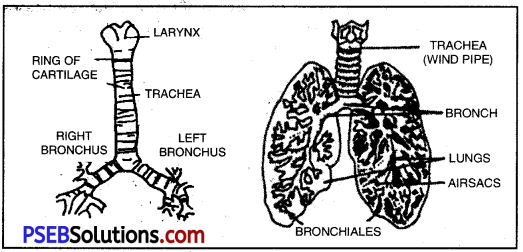
7. Diaphragm.
The main partition which helps in inhaling is called diaphragm. Ib is like a dome, and its central position is projected towards the abdomen. When we breathe, the diaphragm contracts, becomes straight and pushes the liver downwards. When we exhale, these muscles relax and the diaphragm comes back to its original position.
Functions of Respiratory System
The respiratory system has following main functions
1. Every cell of our body gets oxygen with the functioning of the respiratory system.
2. Oxygen causes oxidation. As a result of this phenomenoh, the body gets rid of the waste products produced in it. During metabolism, oxygen combines with hydrogen to form water and with carbon to form cabon dioxide. Water and cabon dioxide are exhaled during exhalation (breathing out.)
Effects of Exercise on Respiratory System
1. Effect on the Factors of Respiration.
The functioning of the respiratory system depends upon factors like the structure of
blood, blood circulation, alkaline reserve, the size of curved chest, the muscles of chest, stomach membrane and acidic nature of blood. Exercise exerts positive effect on all these factors.
2. Increase in the Blood Circulation of Lungs.
More air passes through our lungs by exercise, as a result of which the exchange of gases becomes complete and rapid. Not only does blood get oxygen in proper quantity but there is also an increase in the blood circulation of lungs.
3.Increase in the Lung Capacity.
The lung capacity increases as a result of doing exercise. The high lung capacity is very helpful in doing hard jobs.
4. Expansion of Chest.
The respiration becomes rapid by exercise. It happens because tissues need more amount of oxygen. As a result, heart and lungs have to exert more vigorously. The muscles of chest have also to exert due to exercise, the result of which is that chest expands.
5. Increase in Vital Capacity.
By doing exercise there is an increase in one’s vital capacity. The chest develops as a result thereof. This development is different in different persons. With long time exercises such as marathon, cycling for a long time, one can increase
if one’s vital capacity.
6. Exit of Greater Amount of Carbon Dioxide and Entrance of Greater Quantity of Oxygen in the Body.
The respiratory system and the blood circulatory system are inter-related. Both the activities increase by doing exercise. Thus the greater amount of carbon dioxide exits our body, and greater amount of oxygen enters our body.
7. Increase in the Resistance Powers of the Body.
Lungs develop uniformly as a result of exercises. The respiratory system improves with exercise and with the improved respiratory system, the resistance power of the body also improves.
![]()
Question 2.
What are the effects of Exercise on the Circulatory System ?
Answer:
Blood Circulatory System:
Blood reaches various organs of our body. This is known as blood circulation. The group of parts which participate in this process are known as Blood Circulatory System. This system is a blessing to the human beings. It is through blood that various organs of our body get food and oxygen and carbon dioxide and other waste products excrete through the system.
The following organs of our body take part in blood circulatory system :
- Heart
- Arteries
- Veins
- Capillaries
Blood plays an important role at the time of exercise. At the time of exercise more oxygen is needed for energy in the muscles. By doing exercise the rate of heart beat increases and more blood flows in arteries. The result is that our blood pressure increases. It increases the blood circulation in the body. With the increase in the blood circulation, there is a corresponding increase in activities of the lungs. As a result of some chemical changes in the lungs, the temperature of the body increases. The blood circulation helps in maintaining the balance in this increased temperature. It also sends the waste product produced as a result of chemical action for exeretion to its right place.
Effects of Exercise on the Blood Circulatory System:
The blood circulation is extremely essential for human body. The proper blood circulation makes our body physically fit and healthy. In order to make the right diagnosis, the blood tests of a patient are done at first. These tests reveal any infection in the blood-circulation. Then, the source of infection is removed and the balanced blood is sent to various organs of body. For balanced blood circulation exercise is of great importance.
Exercise has some special effects on our blood circulation, which are as follows :
1. Exhaling of Proper Amount of Carbon Dioxide.
While doing a strenuous exercise the condition of heart is that there is an increase in blood pressure and frequency of palpitation and there is quick movement in blood circulation. The quantity of oxygen is 0.5% in the position of rest, and it increases by 10% at the time of exercise, 15% of increase is needed at the time of doing a heavy exercise. There is also an exhaling of carbon dioxide.
2. Quick Movement of Blood Circulation.
When a person does exercise there is a quick movement of circulation of blood in his body. Blood takes 21 seconds to complete one circle in a position of rest, while it takes 15,10 or even 8 seconds to do so at the time of doing an exercise.
3. Uniform Temperature of Human Body.
Exercise keeps the temperature of human body uniform. With exercise blood circulates quickly in the human body and keeps the temperature of all body organs, even though these organs are covered with clothes or naked such as human face, hands, feet, etc.
4. Increase in the Working of Productive Capacity of Heart.
The muscles of heart function as a central controller. With every contraction of the heart 5 gm. of blood is sent into aorta. It becomes 4 litres in one minute. When a trained player does heavy work, both the sides of his heart send 30 litres of blood per minute. Thus, the working or productive capacity of heart gets increased in this manner. The ratio between simple non-exercising and exercising condition is 1:7.
5. Change in the Composition of Blood.
Exercise brings about a change in the composition of blood. There is an increase of 10% of haemoglobin and red corpuscles in the blood as a result of exercise. There is also an increase in white corpuscles in the blood. We get more oxygen with the increase in red corpuscles. Our body becomes sufficiently strong to combat diseases with the increase in white corpuscles and these corpuscles work as watchmen of our body.
6. Pure Blood. Pure blood is the base of our body.
It is exercise that helps in forming pure blood in adequate quantity in our body. Alcohol, tobacco and other intoxicants badly affect white corpuscles in the blood. It is only by doing exercise that we can keep whitecorpuscles in good condition.
7. Increase in the Supply of Blood.
Exercise increases the supply of blood in our body. Capillaries expand, and even those capillaries which usually remain closed open as we exercise. There is so much increase in the quantity of blood in the outer capillaries of our body that even the colour of our skin appears to be, red.
8. Supplying Greater Quantity of Blood to a Particular Organ.
Sometimes a particular organ of our body requires greater quantity of blood. For example, our stomach needs more blood after taking food. In this condition the arteries of the stomach expand and blood flows greatly in them. Digestive system, therefore, gets improved with exercise. It is through exercise that blood, the base of our life, circulates properly in our body.
For example, the doctor advises theexercise of the paralysed part of a person suffering from paralysis. According to the doctor, that part may start functioning again with the increased flow of blood in it as a result of exercise. That is why, a player is asked to do exercise.
9. Decreasing the Rate of Heartbeat.
The rate of heartbeat of a common man is 72-80 per minute. But if he begins to do vigorous exercise, the capacity of the blood flow in the arteries of his heart increases, and the rate of his heart beat comes down to 60-65 per minute. Thus, the speed of our heart beat decreases with exercise, and there is an increase in the blood supply in the big artery of the heart.
10. Prevention of Diseases.
As a result of exercise, the blood flows through the veins of our body at a rapid speed. The result is that fat does not deposit on the walls of blood veins and arteries, and there is no blockage in the flow of blood. Consequently, a person who does vigorous regular exercise does not fall a prey to diseases like high blood pressure. Blood circulates slowly in the veins in the bodies of non-exercising persons.
Fat gets deposited on the walls of their veins, as a result of which such persons fall a prey to high blood pressure. For example, if the water in the sewerage pipe that takes the dirty waste matter out of the house flows slowly, Some water with waste matter will remain in the pipe and germs will grow and breed on the dirty waste matter. But if the flow of water in the pipe is fast, all the waste matter will flow out with the rapid flow of water , and no waste matter shall remain in the pipe. Similarly, if the blood flow in our body is fast, there will be no blockage and no disease.
![]()
Question 3.
What are muscles ? Describe the effect of exercises on Muscular System.
Answer:
Muscular System. Different organs of our body are covered with flesh which is formed of many muscles together. In our body there are over 500 muscles. 45% of the weight of our body is composed of muscles. Muscles are red coloured chunks of flesh which we can see by removing the upper skin of our body.
Parts of Muscles. There are three following parts of muscles.
1. Belly
2. Insertion
3. Origin.
1. Belly.
The innermost and the thickest part of the muscle is called belly.
2. Insertion.
The part of the muscle connected with movable bone is called insertion.
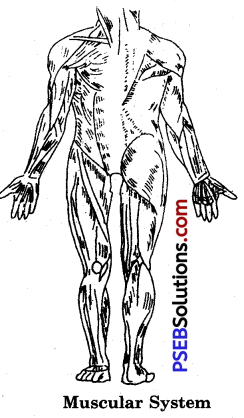
Muscular System
3. Origin.
The part of the muscle connected with immovable bone is known as origin.
Types of Muscles :
Muscles are mainly of two types.
1. Voluntary Muscles:
Voluntary muscles are those muscles which function according to one’s will, such as the muscles of legs and arms.
2. Involuntary Muscles:
These types of muscles do not function according to one’s will. One’s will or desire has no effect upon them. Such muscles are those of heart, liver and intestines.
Every function of our body depends upon the contraction of muscles. Muscles receive messages from the Central Nervous System. On receiving the messages muscles obtain energy from some chemical changes for contraction, and the fibres of muscles assume a new form. The skeleton of our body is composed of thousands of fibres. Fibres are attached to one another because of connective tissues. These fibres are as thick as our hair, and each of these fibres is 1 to 1.5 inches in length
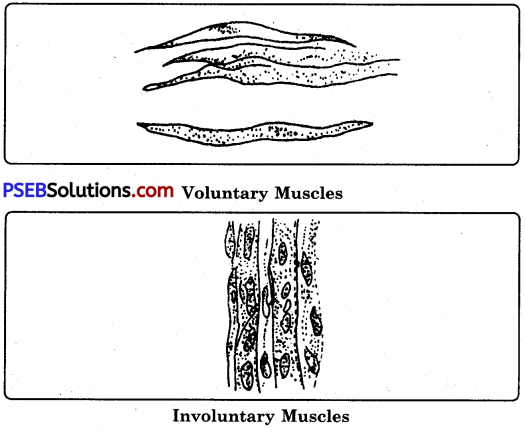
Involuntary Muscles
Each of these fibres is a cell, and it differs in length- and width. This cell has in it a liquid called sarcoplasm which, in turn has myofibrils which are capable of contraction and expansion. It i$ due to these myofibrils that muscles contract and expand. Each fibre is covered with membrane called sarcolemma.
About a hundred of such fibres form a bundle called Fasciculus. Such small bundles form a bigger bundle, and some bundles give rise to a muscle. There are several blood capillaries in a muscle which distribute blood. These blood capillaries form a sort of network. In the state of rest most of these blood capillaries close, but in the state of action or movement, they open up, thereby fulfilling the need of blood.
Effects of Exercise on Muscular System.
The following changes take place in our muscular system as a result of regular exercise :
1. Moving the Muscles and Total Development of the Body:
The chief objective of exercise is to bring the muscles of body into motion. The development of whole body gets stimulated as a result of regular exercise.
2. Respiration Easy and Effective:
Exercise helps in the expansion of chest muscles. As a result of exercise, respiration becomes easy and effective.
3. Quick Response to Minor Excitement:
As a result of regular exercise, muscles become beautiful and flexible. Their tone also improves, resulting in their quick response even when there is minor stimulation or excitement.
4. Co-ordination between Groups of Muscles:
Co-ordination is developed among different groups of muscles by doing regular exercise, and the habit is developed to work together. If there is no or any lack of this co-ordination, it becomes difficult to do certain tasks.
5. Proper Blood Circulation:
The palpitation of heart increases with exercise. As a result of exercise, blood reaches every part of the body properly and adequately, and the muscles of the heart begin to function properly.
6. Increase in the Power of Muscles:
Exercise brings an increase in the power of muscles. This increase in muscle power depends upon the vigour, tempo and frequency of exercise. The hill labourer and carpenter have long and strong arms because they make maximum use of these parts of body while doing their jobs. Swimming, wrestling, gymnastics, weight-lifting, basketball, football and many other games help in development in the muscle power.
7. Effects on Bones and Joints:
Regular exercise affects bones and joints immensely. By doing exercise the bone muscles become strong and developed. Bones also increase. The bones ofchildren are thin, soft and amorphous. The activity of their muscles have much good effect. Owing to lack of activity their bones remain soft and begin to assume ugly look.
8. Maintaining Muscles in Working Order:
As a result of regular exercise muscles remain in good working order. They are capable of fulfilling various needs of body. They have the power to expand in proportion and in size. It is possible only if we get adequate food. But if muscles are not put to proper use, even the good food will fail to bring about any increase in their size and power.
9. Increase in the Size of Muscles in Length and Breadth:
By doing exercise one can increase muscles in size, in length as well as breadth. For example, if one exercises arms with weight or perform ‘dandas’, there will be an increase in the size of arm muscles. The biceps and triceps of arms will begin to looks strong and thick.
10. Assistance to Maintain Correct Body Posture in Old Age:
As a result of regular exercise muscles in the body become strong and increase in size. It helps one in old age in keeping correct body posture. But if one has not done exercise and the muscles have remained weak, one may suffer from hunchback and other bad states of health in old age.
11. Increase in the Neuro-Muscular Co-ordination:
Regular exercise increases the neuro-muscular co-ordination. For example, a player hits the ball, the rival player is able to block the hit by immediately turning his body the moment the hit is taken. The kick is made in the twinkling of an eye but the rival player is able to stop the ball because of his excellent neuro-muscular co-ordination.
12. Increase in the Speed of Deoxygenated Blood towards the Heart:
When we do exercise oxygenated blood reaches the minutest cells of the muscles in our body, and deoxygenated blood therefrom quickly travels to the heart for purification. By doing exercise one increases the speed of deoxygenated blood towards the heart, because with exercise the cells need more oxygenated blood.
![]()
Question 4.
What are the effects of exercises on the Excretory System?
Answer:
Excretory System:
Excretory system is the one by which harmful and wasteful products are excrete from our body. If these useless and harmful products remain inside the body, the body becomes a victim of many diseases. Among these wasteful products are urea, carbon dioxide, perspiration and water. These products excrete through different organs like lungs, kidneys, skin and intestines.
Effects of Exercise on Excretory System:
Exercise has good effect on excretory system. Some of these.good effects are as follows
- Body gets activated as a result of exercise. The blood circulation increases thereby. Due to exchange of gases in the body, food elements get digested and waste products get excreted. It helps in keeping the temperature of the body uniform.
- Muscles have to get into motion as a result of exercise. It results into some body change. The dirty elements come out of the skin, and the body remains free from skin diseases.
- With exercise poisonous and waste products continue to be excreted from body. Diseased germs do not get accumulated in the body. The body becomes able to fight out these diseased germs.
- Kidneys expel out waste products in the form of urine. They act as sieve. With exercise they become activated and efficient.
Question 5.
Write a short note on the followings :
- Functions of Skin
- Kidneys
- Heart
- Arteries and Veins
Answer:
1. Skin and their Functions
Skin-Structure and Functions:
Skin is the outermost covering of the body. It keeps the whole body covered, and protects all the muscles and other organs of the body. It maintains the body temperature.
Structure
Skin has two layers:
(i) the outer layer called Epidermis and
(ii) the inner layer called Dermis.
Epidermis: The outer skin, that is, epidermis, is made by mixing of several layers of cells. The first layer is made of lifeless, hard transparent and colourless, countless cells. Its thickness is different in different parts of the body. It is 1/200 cms., on the face and 1/20 cm. on the heels. It has no blood vessels.
So when this part of the skin in cut, neither does the blood flow nor is pain felt. Just as a snake casts away its outer skin, so does our outer skin get worn out and old skin is replaced with the new. There are pigment grains in the lower surface of the epidermis. They are greater in number in dark coloured people as compared to the fair-complexioned. The main function of epidermis is to protect dermis.
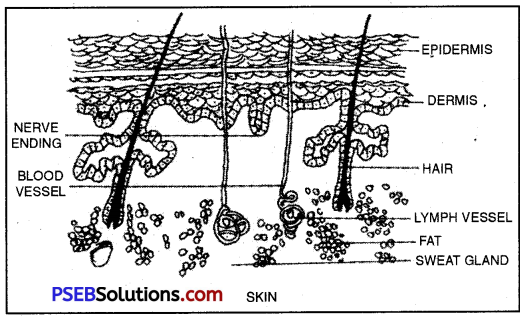
If we examine the skin under a microscope, we see very small holes. These are the mouths of sweat glands by means of which the waste products of the body come out in the form of sweat.
Dermis:
It is also known as inner-skin. It is below the outer skin, that is, epidermis. It is made of connective tissues. It has many small and big blood vessels. Moreover, there are nerve fibres which function like small machines.It continues to collect feelings, experiences, excitements and sensations.. The collection of these sensations reaches the brain.
Skin Glands:
There are two types of glands in the inner skin.
1. Sweat Glands.
The sweat glands are 20-50 lakhs in number. These are present in all organs of the body except lips, sex organs, etc. They are present in greater number on the palms of the hands and soles of feet. Sweating results in lowering of body temperature. When sweat dries up, it takes up heat from the body, as a result of which the body temperature is lowered.
2. Sebaceous Glands. These glands are related only to the roots of the hair.
When sweat is formed, it does not have foul sihell, but when the bacteria of the skin act upon it, it starts emitting foul smell.
Functions of the Skin:
- It covers and protects the body.
- It protects our body from heat and cold.
- It is an organ of excretory system. It purifies blood by excretingwaste products such as urea and non-living mineral substances through sweat.
- It keeps the body beautiful. Had there been no skin, our bodyWould have looked like a dreadful skeleton.
- It maintains the temperature of the body.
- It produces in us the sensations of warmth and coldness.
- It acts as a sensory organ.
- It prevents disease germs from entering our body.
2 Kidneys
Structure and Functions of Kidneys
Kidneys: Kidneys are two in number. These are located towards the back side of stomach. They are in shape like that of bean. They help in excreting urine from the body. They keep the quantities of water and blood equal. Urea, uric acid, minerals etc. continue to be excreted from the body through these orgAnswer:If it is cut and viewed, an empty space will be seen. There are fine tubules around this empty space. They are pretty long and curve together to join other tubules.
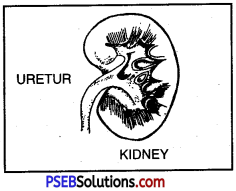
The external part of each kidney is convex while the internal is concave. The open space in the concave part is known as Hilum. It is here that the renal artery enters and the renal vein comes out of the kidney. It collects the blood and takes it to the renal vein. Every ureter is 10″ long and opens into a bag after covering full distance. This bag is known as urinary bladder. Urine collects in this bag.
![]()
Functions of Kidneys:
- The waste matter of the body mixes with the blood and forms urea. Urea mixes with blood and enters the kidneys.
- Urea mixed with blood comes into the cells of the kidneys.
- These tubules pull out toxic substances like uric acid circulating in arteries and veins around the nerves.
- Kidneys filter toxic substances like uric acid.
- The waste matter dissolves in water and goes Into the big tubes of the towers inside the kidneys.
- The tops of the kidney towers have holes. The waste matter and water come in the upper broad portion by means of ureter through these holes.
- From the broad side this urine gets excreted through urethra.
3 & 4 Heart, Arteries and Veins:
The major portion of the amount of blood of the human body remains in this part. It is made of flexible tissues of flesh. It is an extremely delicate and the most important organ of the body. It is located to the left of the chest. It resembles a closed fist in size.
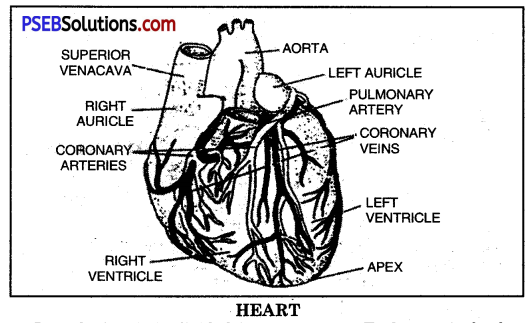
Lengthwise, it is divided into two parts. Each part is further divided into two parts upper and lower parts. The upper parts are called auricles, and the lower parts are called ventricles. The pure blood from different parts of the body reach the right auricle by veins and then reach the right ventricle by tricuspid valve. From right ventricle blood reach lungs for purification through pulmonary artery, and on its way back oxygenated blood reach left auricle of the heart. It reaches the left ventricle by bicuspid valve. From the left ventricle blood reaches different parts of body through Aorta. Thus, the blood continues to circulate in this manner.
Veins and Arteries
The pipes which bring the blood from lungs, and from other parts of the body to the heart are known as veins. The structure of the walls of veins resembles that of arteries, but the layer of their flexible tissues and muscles is very thin. Except pulmonary vein, all other veins carry the deoxygenated blood to the heart.
Arteries:
Arteries carry the oxygenated blood from heart to various parts of our body. These are made of flexible, but thick walls. Oxygenated blood flows through them. But the artery which carries blood to lungs has in it deoxygenated blood.This artery carrying deoxygenated blood is known as Pulmonary Artery. The prominent of all arteries is called Aorta.
